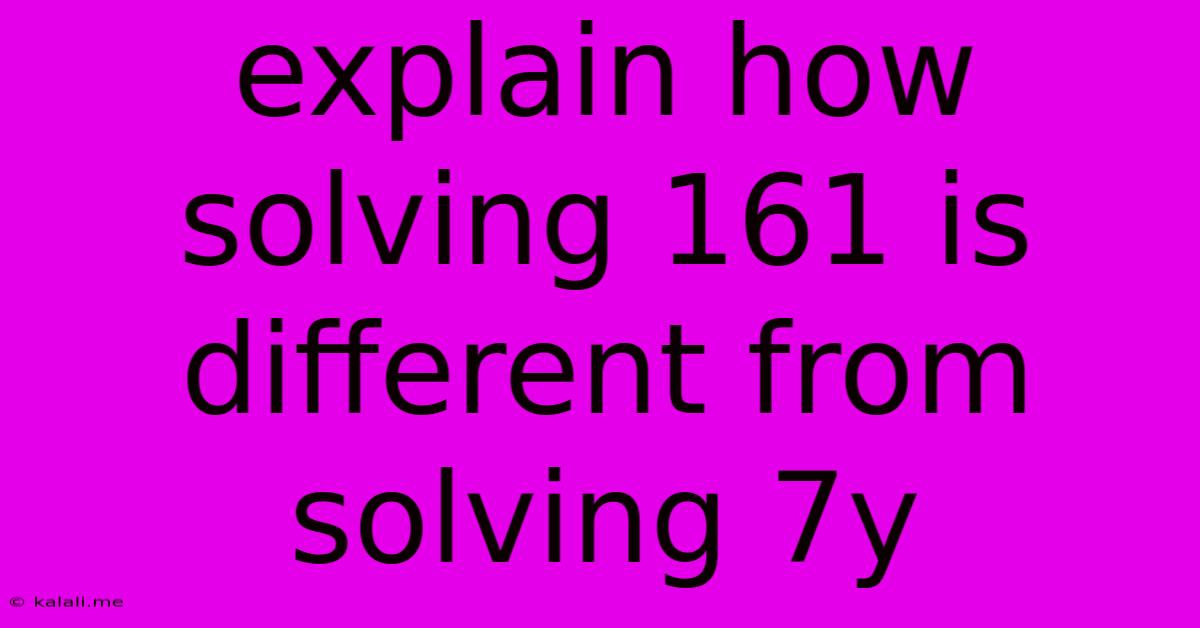Explain How Solving 161 Is Different From Solving 7y
Kalali
May 09, 2025 · 2 min read

Table of Contents
Unpacking the Differences: Solving 161 vs. Solving 7y
This article will delve into the core differences between solving the equation 161 and solving the equation 7y. While seemingly simple, understanding these distinctions reveals fundamental concepts in algebra and equation solving. This is crucial for anyone learning basic algebra or looking to refresh their understanding of variable manipulation.
Understanding the Nature of the Problems:
The key difference lies in the nature of each "problem." 161 is a constant; it represents a fixed numerical value. There's nothing to "solve" for; it is the solution. On the other hand, 7y is an algebraic expression. It represents a relationship between a coefficient (7) and a variable (y). Solving 7y implies finding the value of the variable 'y' that satisfies a given equation.
161: The Constant Case
There’s nothing to solve for in 161. It's a complete statement. The number 161 stands on its own; it's already in its simplest form. Any further manipulation wouldn't change its value. Think of it as the answer to a question, not a question itself. For example, "What is the sum of 100 and 61?" The answer is 161.
7y: The Algebraic Equation Case
7y, in contrast, requires further information to be solved. To find the value of 'y', we need an equation. Let's assume we have the equation:
7y = 161
In this case, we're solving for 'y'. This involves applying algebraic principles to isolate the variable. Here's how we would solve it:
- Divide both sides by 7: This is the inverse operation of multiplication (7 is multiplying y). Dividing both sides by 7 maintains the equality.
- Simplify: This leads us to: y = 161/7 = 23.
Therefore, the solution to the equation 7y = 161 is y = 23. This means that if you substitute 23 for 'y' in the original equation, the equation holds true: 7 * 23 = 161.
Key Differences Summarized:
| Feature | Solving 161 | Solving 7y (e.g., 7y = 161) |
|---|---|---|
| Nature | Constant, a fixed numerical value | Algebraic expression, involves a variable |
| Solution | The number itself (161) | The value of the variable (y) |
| Process | No solving process required | Requires algebraic manipulation (division in this example) |
| Result | No further simplification needed | A numerical value for the variable |
Conclusion:
Understanding the difference between solving a constant like 161 and solving an algebraic expression like 7y is fundamental to grasping basic algebraic principles. While 161 simply represents a numerical value, 7y represents an unknown quantity that can be determined through applying algebraic operations within an equation. Mastering this distinction paves the way for tackling more complex algebraic problems and equations.
Latest Posts
Latest Posts
-
R C Cola And A Moon Pie
Jul 04, 2025
-
If I Was 18 What Year Would I Be Born
Jul 04, 2025
-
One And Three Hundred Twenty Four Thousandths
Jul 04, 2025
-
How Much Is 2 Pounds Of Cream Cheese
Jul 04, 2025
-
How Do You Pronounce M I C H A L
Jul 04, 2025
Related Post
Thank you for visiting our website which covers about Explain How Solving 161 Is Different From Solving 7y . We hope the information provided has been useful to you. Feel free to contact us if you have any questions or need further assistance. See you next time and don't miss to bookmark.